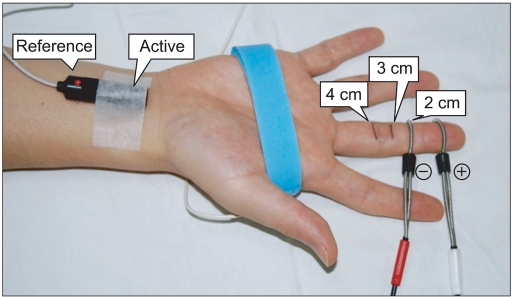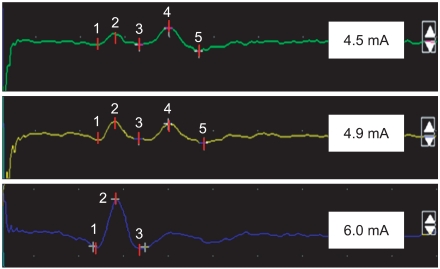Ann Rehabil Med.
2011 Aug;35(4):541-547. 10.5535/arm.2011.35.4.541.
Double-Peak Response in Orthodromic Sensory Nerve Conduction of the Median Nerve
- Affiliations
-
- 1Department of Physical & Rehabilitation Medicine, School of Medicine, Inha University, Incheon 400-711, Korea. jacob.kim@inha.ac.kr
- 2Department of Physical & Rehabilitation Medicine, Pusan National University School of Medicine, Yangsan 626-770, Korea.
- KMID: 1971721
- DOI: http://doi.org/10.5535/arm.2011.35.4.541
Abstract
OBJECTIVE
To understand the neural generator of double-peak potentials and the change of latency and amplitude of double peaks with aging. METHOD: In 50 healthy subjects made up of groups of 10 people per decade from the age of 20 to 60, orthodromic sensory nerve conduction studies were performed on the median nerves using submaximal stimulation. Various stimulus durations and interstimulation distances were used to obtain each double peak in the different age groups. The latency and amplitude of the second peak were measured. Statistical analyses included one-way ANOVA and correlation tests. p-values<0.05 were considered significant.
RESULTS
When the cathode moved in a proximal direction, the interpeak intervals increased. Second peak amplitudes decreased, and second peak latencies were delayed with aging (p<0.05). In some older people, second peaks were not obtained.
CONCLUSION
Our experiments indicate that the double-peak response represented the two stimulation sites under the cathode and anode. The delayed latency and decreased amplitude of the second peak that occurs with aging represented peripheral nerve degeneration in aging, which starts at the distal nerve.
Figure
Reference
-
1. Aprile I, Stalberg E, Tonali P, Padua L. Double peak sensory responses at submaximal stimulation. Clin Neurophysiol. 2003; 114:256–262. PMID: 12559232.
Article2. Jennekens FG, Tomlinson BE, Walton JN. Histochemical aspects of five limb muscles in old age. An autopsy study. J Neurol Sci. 1971; 14:259–276. PMID: 4257497.
Article3. Tohgi H, Tsukagoshi H, Toyokura Y. Quantitative changes with age in normal sural nerves. Acta Neuropath. 1977; 38:213–220. PMID: 899722.
Article4. Lascelles RG, Thomas PK. Changes due to age in intermodal length in the sural nerve in man. J Neurol Neurosurg Psychiatry. 1966; 29:40–44. PMID: 5910577.5. Buchthal F, Rosenfalck A. Evoked action potentials and conduction velocity in human sensory nerves. Brain Res. 1966; 3:74–78.
Article6. Nolano M, Simone DA, Wendelschafer-Crabb G, Johnson T, Hazen E, Kennedy WR. Topical capsaicin in humans: parallel loss of epidermal nerve fibers and pain sensation. Pain. 1999; 81:135–145. PMID: 10353501.
Article7. Lynn B. Capsaicin: actions on nociceptive C-fibers and therapeutic potential. Pain. 1990; 41:61–69. PMID: 2162021.8. Simone DA, Nolano M, Johnson T, Simone Da, Nolano M, Johnson T, Wendelschafer-Crabb G, Kennedy WR. Intradermal injection of capsaicin in humans produces degeneration and subsequent reinnervation of epidermal nerve fibers: correlation with sensory function. J Neurosci. 1998; 18:8947–8959. PMID: 9787000.
Article9. Aprile I, Tonali P, Stalberg E, Di Stasio E, Caliandro P, Foschini M, Vergili G, Padua L. Double peak sensory responses: effects of capsaicin. Neurol Sci. 2007; 28:264–269. PMID: 17972041.
Article10. Provitera V, Nolano M, Pagano A, Caporaso G, Stancanelli A, Santoro L. Myelinated nerve endings in human skin. Muscle Nerve. 2007; 35:767–775. PMID: 17405136.
Article11. Nolano M, Provitera V, Crisci C, Stancanelli A, Wendelschafer-Crabb G, Kennedy WR, Santoro L. Quantification of myelinated endings and mechano receptors in human digital skin. Ann Neurol. 2003; 54:197–205. PMID: 12891672.12. Dumitru D, Amato AA, Zwarts M. Dumitru D, editor. Nerve conduction studies. Electrodiagnostic medicine. 2002. 2nd ed. Philadelphia: Hanley & Belfus Inc;p. 187.
Article13. Dumitru D, Amato AA, Zwarts M. Dumitru D, editor. Nerve conduction studies. Electrodiagnostic medicine. 2002. 2nd ed. Philadelphia: Hanley & Belfus Inc;p. 188.
Article14. Bolton CF, Carter KM. Human sensory nerve compound action potential amplitude: variation with sex and finger circumference. J Neurol Neurosurg Psychiatry. 1980; 43:925–928. PMID: 7441272.
Article
- Full Text Links
- Actions
-
Cited
- CITED
-
- Close
- Share
- Similar articles
-
- Pitfalls in Superficial Radial Sensory Nerve Conduction Study
- Antidromic and Orthodromic Sensory Conduction of Ring Finger in Carpal Tunnel Syndrome
- The Diagnostic Value of Segmental Nerve Conduction Study in Diabetics
- Reappraisal of Supraorbital Sensory Nerve Conduction Recordings: Orthodromic and Antidromic Techniques
- The Value of Parameters from Median Nerve Conduction Studies for the Diagnosis of Carpal Tunnel Syndrome




